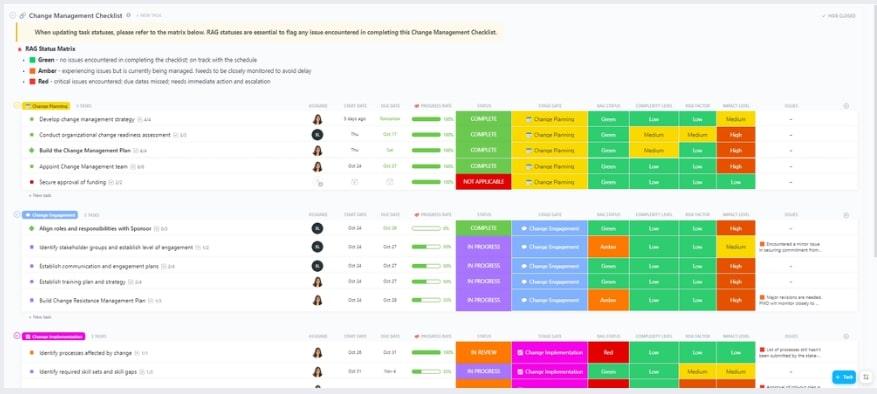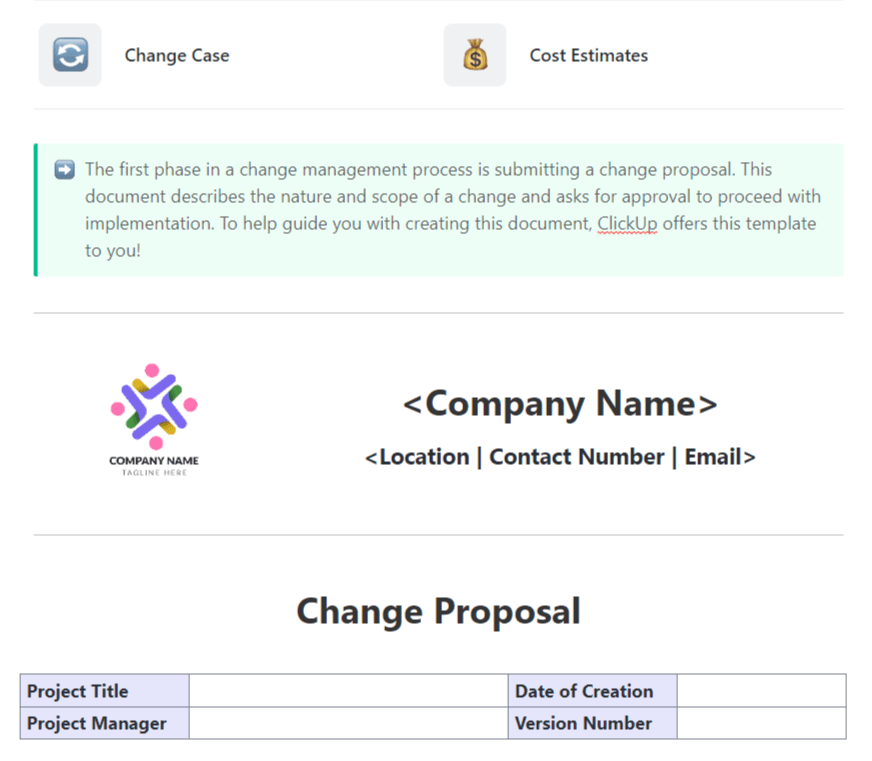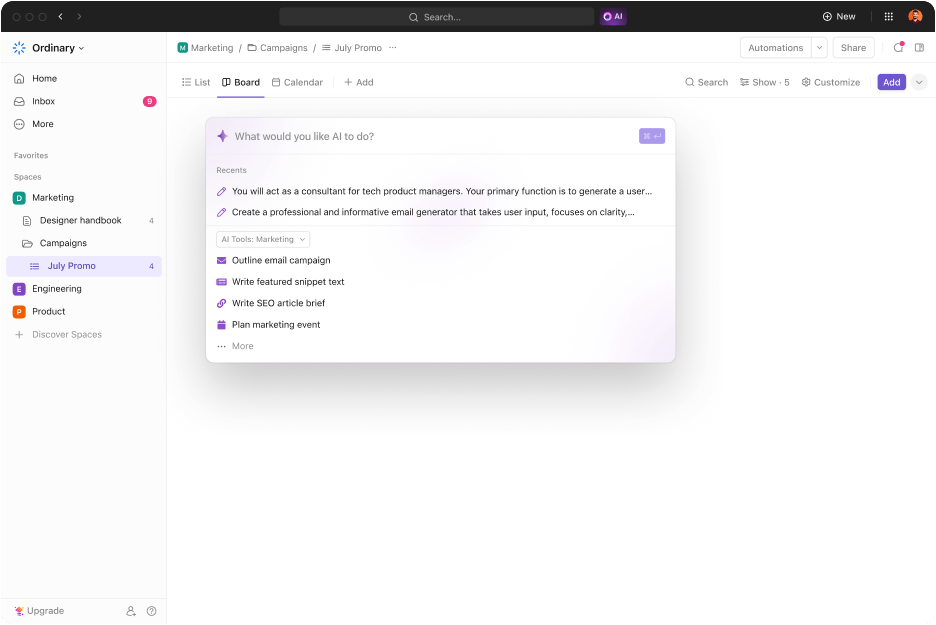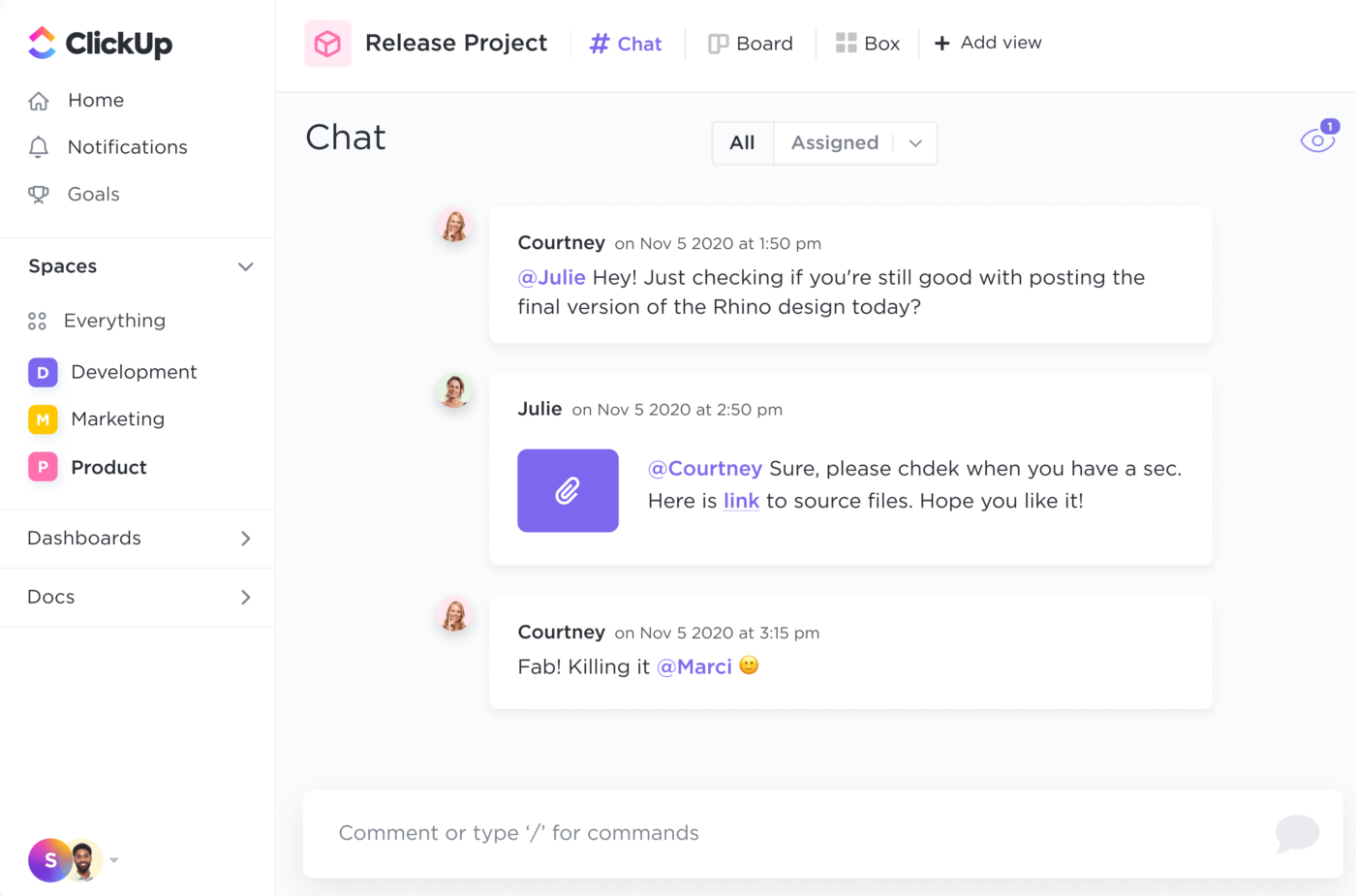إن دور القائد التنظيمي يشبه إلى حد كبير دور البستاني. كقائد، أنت تتعامل دائمًا مع عوامل التغيير، ويتطلب جزء كبير من عملك قيادة الناس من خلال التحولات ورعايتهم وضمان نموهم. 🌱
إحداث التغيير التنظيمي هو موضوع ثابت في الشركات الناجحة. انظر فقط إلى مايكروسوفت أو آبل أو تسلا - فجميعها مؤسسات يقودها قادة أصحاب رؤية رفضوا الوضع الراهن وتبنوا النمو من خلال جهود التغيير.
المشكلة الوحيدة هي أن قيادة التغيير الفعالة ليست مفهومًا مباشرًا. في المتوسط, 70% من مبادرات التغيير تفشل بسبب تحديات مثل مقاومة الموظفين وضعف الرؤية في الصورة الأكبر.
في هذا الدليل، سنستكشف في هذا الدليل تعقيدات القيادة الناجحة في التغيير، والتي تغطي:
- نماذج قيادة التغيير المثبتة
- 10 استراتيجيات لتصبح قائد تغيير ناجح
- نصائح لتجنب التهديدات أثناء قيادة التغيير
ما هي قيادة التغيير؟
تتطلب أي مبادرة للتغيير، مثل تنفيذ استراتيجية عمل جديدة أو نموذج تشغيلي جديد، جهدًا مكثفًا. أنت بحاجة إلى خطة استراتيجية خطوة بخطوة، ووحدات تدريبية، ونظام دعم للسماح لأصحاب المصلحة بالتغلب على التحديات المتعلقة بالتغيير والوصول إلى النتيجة المرجوة.
قيادة التغيير هي نهج يركز على الأفراد للتعامل مع النزاعات والمفارقات المتأصلة مع تسهيل التحولات على المستوى التنظيمي. وهي توجه القادة لتوظيف قوتهم للتأثير على الآخرين وإلهامهم للعمل.
وقد أكد الباحثان البارزان في مجال القيادة مالكولم هيغز وديبورا رولاند على أن قيادة التغيير الناجحة تتمحور حول قيادة الناس بعناية وبصيرة. وفيما يلي كيفية تعريفهما لهذا المفهوم في كتابهما دراسة شهيرة :
_قيادة التغيير هي القدرة على التأثير على الآخرين وإثارة حماستهم من خلال الدعوة الشخصية والرؤية والدافع للوصول إلى الموارد لبناء قاعدة صلبة للتغيير
بالإضافة إلى ذلك، فإن نهج قيادة التغيير يؤسس للتغيير كمبادرة مستمرة داخل المنظمة - وليس كمشروع محدود. يجب على القائد أن يهيئ نفسه لمهام مثل:
- تحديد فرص التغيير للنمو التنظيمي
- توقع الضغوطات القائمة على الانتقال التي قد تؤدي إلى مقاومة الموظفين
- الإشراف على مبادرة إدارة التغيير من حيث النطاق والسرعة والمساءلة
نصيحة احترافية: هل تحتاج إلى إطار عمل سريع لتخطيط وقيادة التعديلات التنظيمية؟ انتقل إلى نموذج قائمة مراجعة إدارة التغيير ClickUp Change Management لتحديد عمليات وبروتوكولات التغيير، وإدارة التكاليف، وإعداد فريقك للمبادرة المقترحة. 💪

تتبع كل شيء من أجل انتقالك باستخدام هذا التغيير قائمة مراجعة الإدارة القالب
/ctaBtn/الأخضر https://app.clickup.com/signup?template=t-200695286 تنزيل هذا القالب /%ctaBtnTn/
قيادة التغيير مقابل إدارة التغيير
غالبًا ما يتم استخدام قيادة التغيير و إدارة التغيير بالتبادل، ولكن التمييز بينهما يتجاوز مجرد دلالات الألفاظ. إدارة التغيير تنطوي على استخدام مجموعة من الأدوات أو الهياكل من أجل الحفاظ على السيطرة على أي جهد تغييري - والهدف هنا هو إدخال التحولات داخل الشركة بشكل تدريجي. ينصب التركيز على العملية التكرارية والفرض من أعلى إلى أسفل. أنت تسمح بإجراء تعديلات صغيرة النطاق للتخفيف من تأثير التغيير بوتيرة محسوبة، مما يجعل المبادرة فعالة من حيث التكلفة ويقلل من التعطيل ومخاطر الفشل.
من ناحية أخرى، تتبنى قيادة التغيير منظورًا ثوريًا طويل الأمد. إنها القوة والرؤية التي تدفع العمل نحو تحول واسع النطاق. وهي تُمكّن كل فرد داخل الشركة من أن يكون عاملاً للتغيير، مع التركيز على الثقافة التعاونية بدلاً من الفرض من أعلى إلى أسفل.
وفقًا لـ بحث جارتنر حول التغيير التنظيمي ، فإن 80% من الشركات تتبع نهج إدارة التغيير من أعلى إلى أسفل، حيث تقوم بتنفيذ القرارات الاستراتيجية من خلال التواصل على مستوى المؤسسة. ومع ذلك، فإن معدل نجاح هذا النهج لا يتعدى 34% فقط، وغالبًا ما يتفاقم هذا النهج بسبب الفجوات في التواصل بين المديرين التنفيذيين والموظفين المبتدئين.
وإدراكًا لهذه العوائق، يفضل رؤساء الموارد البشرية (CHROs) في جميع أنحاء العالم النموذج الاجتماعي لقيادة التغيير، والاستفادة من العوامل المجردة مثل بيئة العمل الإيجابية والذكاء العاطفي والتزام الفريق لإحداث التغيير.
من هو قائد التغيير، وكيف يختلف عن مديري التغيير؟
لا يعمل قائد التغيير البارع كقائد تغيير منفّذ بل كميسّر، حيث يقوم بتوجيه المديرين وأعضاء الفريق بشكل تعاوني لدمج التغيير
يميز قادة التغيير أنفسهم عن مدراء التغيير من خلال التركيز على مبادرات التحول طويلة الأجل. فبدلاً من فرض توجيهات جديدة، يقومون بتمكين الموظفين من المساهمة في مبادرات التغيير.
على المستوى الكلي، تتمثل المسؤولية المحورية لقائد التغيير في تعزيز الثقة بين الموظفين وبناء الثقة الجماعية في التغييرات المقترحة. إليك بعض المهارات الأساسية التي يتحلى بها قادة التغيير الناجحون:
- التواصل المفتوح
- روح التعاون
- الالتزام بمساعدة الموظفين على الشعور بالأمان
- موقف القدرة على العمل
- الفضول لاستكشاف الاستراتيجيات الواعدة
- الذكاء العاطفي
- التفكير الاستراتيجي
- القدرة على التكيف شركة جنرال إلكتريك (GE) ، وهي شركة رائدة متعددة الجنسيات، دراسة حالة مثالية لتسجيل تأثير قادة التغيير. فقد أطلقت الشركة مبادرات تغيير ناجحة من خلال الاستفادة من ذكاء السوق من خلال الاستخدام المستدام لرأس المال البشري. فقد شهدت قفزة بنسبة 25% في عائد الاستثمار من خلال الدفع نحو مزيد من الإبداع في الأدوار القيادية.
4 نماذج مثبتة لقيادة التغيير لقيادة التغيير بفعالية
يوفر نموذج قيادة التغيير هيكلاً لتعزيز المشاركة الجماعية ومساعدة الشركة على التطور. دعونا نناقش أربعة أطر عمل للتغيير شائعة يستخدمها القادة الناجحون.
1. نموذج ماكنزي 7-S
تم تطوير هذا النموذج من قبل روبرت ووترمان الابن وتوم بيترز في أواخر السبعينيات، ويحدد هذا النموذج سبعة مكونات كمفاتيح للتغيير الفعال:
- القيم المشتركة
- الهيكلية
- النمط
- المهارات
- طاقم العمل
- الأنظمة
- الاستراتيجية

عبر: ماكينزي وشركاه تكمن الفكرة في استخدام هذه المكونات السبعة لاستعادة الاستقرار أثناء تنفيذ مبادرة التغيير. تقوم ببناء سلسلة قيادة و تحديد كل خطوة من خطوات العملية مع مراعاة كل من العوامل التشغيلية والعاطفية.
غالبًا ما يعمل نموذج ماكنزي 7-S في سلاسل الأعمال الكبيرة مثل ماكدونالدز ولكنها تميل إلى تحقيق معدلات نجاح أقل بشكل عام بسبب تعقيدها.
2. نموذج كوتر المكون من 8 خطوات
قام الأستاذ المتقاعد من كلية هارفارد للأعمال والمستشار الإداري الرائد جون كوتر بتطوير منهجية منهجية من ثماني خطوات للحفاظ على الزخم من أجل تغيير تنظيمي دائم. ويتضمن نموذجه ما يلي:
- خلق شعور بالإلحاح الذي يسمح للموظفين برؤية المشاكل المتعلقة بالوضع الراهن وتبني التغيير
- بناء فريق تغيير من قادة الإدارات وموظفي الموارد الرئيسية
- صياغة بيان رؤية لتحديد الخطوط العريضة:
- مبادرة التغيير المنشود
- الخطوات اللازمة لتحقيق ذلك
- توصيل الرؤية إلى المؤسسة بأكملها
- إزالة العوائق التي تحول دون التغيير من خلال العمل، مثل:
- تقديم أدلة التدريب
- الحفاظ على الموارد لدعم التغيير
- تطوير ثقة الموظفين وقبولهم من خلال تحقيق مكاسب قصيرة الأجل
- الاستفادة من المكاسب الصغيرة للحفاظ على الزخم
- ترسيخ التغيير في ثقافة الشركة وعملياتها
هذا النموذج هو الأنسب للمؤسسات الكبيرة، ولكن غالباً ما يتم انتقاده لعدم تضمينه ملاحظات الموظفين.
3. نهج باخاراتش
تشجع هذه الطريقة، التي طورها الأستاذ في جامعة كورنيل صامويل باخاراتش الأستاذ بجامعة كورنيل، القادة على أن يكونوا وكلاء للتغيير من خلال صياغة خطة التغيير بشكل مدروس والسماح لها بالتغلغل في الشركة بشكل عضوي.
يهدف نهج باخاراتش إلى الحد من الآثار السيئة لفلسفة "من أعلى إلى أسفل" - لا تعلن عن التغيير وتترك الموظفين يتعاملون معه، بل قم بالأساس لضمان تقبل فريقك للمبادرة من الناحية النفسية. ينصب التركيز على:
- وضع جدول أعمال للتغيير
- رسم خريطة للتضاريس التشغيلية والثقافية للمؤسسة
- طرح أساليب العصف الذهني لجعل فريقك يدعم جدول الأعمال
- إفساح المجال لفريقك لتقبل التغيير
4. نموذج ADKAR
تم تطويره من قبل رائد الأعمال الناجح جيفري هيات، وهو نموذج نموذج ADKAR يركز على تثقيف الموظفين حول قيمة التغيير والتحولات في حياتهم اليومية. وبصفتك قائدًا، فإنك تدعمهم من خلال خمس مراحل: A الوعي، الوعي، الرغبة، المعرفة، القدرة ، القدرة ، و التنفيذ.
يقدم هذا النموذج نهجًا قويًا يركز على الأفراد في قيادة التغيير، مع التركيز على إدارة الجانب الإنساني من الأمور لتحقيق النجاح. من المرجح أن يتعاون الموظفون المتفاعلون ويكونوا أكثر إنتاجية أثناء عمليات إدارة التغيير.
10 استراتيجيات لتصبح قائد تغيير فعّال في عام 2024
بغض النظر عن نموذج قيادة التغيير الذي تختاره، هناك ممارسات معينة مشتركة بين معظم أطر العمل. لقد قمنا بتجميع 10 استراتيجيات يجب استخدامها والتي ستساعدك على أن تصبح قائد التغيير الأكثر تقدمًا على أي نطاق. سنستكشف أيضًا الحلول ضمن مجموعة إدارة المشاريع من ClickUp التي تجعل العمليات المتعلقة بالتغيير أكثر سلاسة. 🌻
1. وضع رؤية واضحة مع تحديد OKRs محددة
يتوقع قادة التغيير الناجحون مخاوف الموظفين ويدمجون الحلول في رؤيتهم. يجب أن توضح الرؤية كيف يتماشى التغيير المقترح مع قيم الشركة الأساسية ويؤدي إلى الرفاهية التنظيمية، مما يساعد الموظفين على التغلب على المخاوف والاستمرار في المشاركة في عمليات إدارة التغيير.
إحدى طرق تعريف أهداف الفريق لأي عملية تغيير هي من خلال الأهداف والنتائج الرئيسية (OKRs). وقد برز دور OKRs في القيادة التحويلية عندما برز دور OKRs في القيادة التحويلية عندما قام لاري بيج، الرئيس التنفيذي لشركة ألفابيت والمؤسس المشارك لشركة Google, يشهد على تأثيرهم على نمو جوجل :
_OKRs ساعدونا على تحقيق نمو 10 أضعاف، عدة مرات. لقد ساعدوا في جعل مهمتنا الجريئة بجنون المتمثلة في "تنظيم معلومات العالم" أكثر قابلية للتحقيق. لقد أبقوا بقية الشركة وأبقوني أنا وبقية أعضاء الشركة في الوقت المناسب وعلى المسار الصحيح عندما كان الأمر مهمًا للغاية صياغة أفضل OKRs للتغيير هو أمر سهل المنال مع نظام الكل في واحد أداة إدارة المشروع مثل انقر فوق . على سبيل المثال، مع أهداف النقر ، يمكنك تطوير أهداف قابلة للقياس ومحددة زمنيًا يمكن تتبعها عبر مراحل مختلفة من مبادرة التغيير الخاصة بك - وهذا يسمح لك بتسجيل انتصارات صغيرة والحفاظ على تحفيز فريقك.
المكافأة: اكتب رؤية مؤثرة وواضحة للتغيير مع نموذج مقترح التغيير ClickUp للتغيير . يسمح لك بتبسيط جميع الخطوات المقترحة و OKRs والموارد المقترحة لإبقاء أصحاب المصلحة على اطلاع دائم بما هو قادم.

اتخذ الخطوة الأولى نحو تجديد هيكل شركتك مع قالب اقتراح التغيير المصمم من قبل الخبراء
/ctaBtn/الأخضر https://app.clickup.com/signup?template=kkmvq-6142604 تنزيل هذا القالب /%ctaBtntn/
2. صياغة خطة استراتيجية عملية المنحى
قم بإشراك فريقك في مناقشة مفصلة ووضع خطة شاملة لتنفيذ التغيير. استهدف الاستفادة من الشفافية في بناء الثقة و الحفاظ على تحفيز الموظفين وتمكينهم من التواصل مع رؤيتك وفهم أدوارهم في ضمان النجاح.
اتخذ الخطوة الأولى نحو وضع خطط العصف الذهني مع ClickUp Whiteboards تم اختيارها من قبل G2 كواحدة من الشركات الرائدة في السبورة البيضاء التعاونية في 2023. باستخدام هذه الميزة، يمكنك تحويل أي عنصر على اللوحة إلى مهمة ببضع نقرات فقط، مما يسمح لفريقك بالعمل على الأفكار المعتمدة على الفور.

استخدم ClickUp Whiteboards لتعيين المهام، ووضع علامات على المعينين، وأي شيء مطلوب لبدء تعاونك التالي
أنهِ عملية وضع الأفكار من خلال تصور كل جزء من خطة التغيير التي قمت بإنشائها - بما في ذلك الأولويات والهياكل والسلوكيات والموارد المطلوبة - بمساعدة انقر فوق الخرائط الذهنية . تساعد هذه الميزة على ربط مكونات الخطة بالعمليات على لوحة مرئية، مما يسهل على أصحاب المصلحة الرئيسيين فهم الصورة الكبيرة بسرعة.
3. إنشاء وثائق مفصلة عبر مراحل التغيير
قد تبدو مبادرات التغيير مخيفة لأنها تجلب عدم اليقين إلى جداول الموظفين. الحل؟ تخلص من هذا الخوف من خلال التوثيق المفصل الذي يمكن أن يرشد زملائك في الفريق في كل خطوة على الطريق. مستندات ClickUp هو أفضل صديق لك هنا! توفر هذه الميزة منصة منظمة لإنشاء مستندات متنوعة، بما في ذلك قواعد المعرفة وأدلة المستخدم وتعديلات العمليات وإجراءات التشغيل الموحدة. مع عدد غير محدود من الصفحات والوظائف مثل التحرير التعاوني والعناوين المحددة مسبقًا، يمكنك إنشاء مركز موارد ثري لدعم مبادرة التغيير في وقت قصير.

استخدم ClickUp AI لتحرير أو تلخيص أو التدقيق الإملائي أو ضبط طول المحتوى داخل المستندات
الـ العلاقات داخل المستندات تبسط إدارة الملفات من خلال السماح لك بربط المهام والصفحات ذات الصلة، مما يضمن سهولة الوصول إليها. يمكنك أيضًا وضع علامات على المستندات لمساعدة زملائك في الفريق على استرداد المعلومات بشكل أسرع.
بالإضافة إلى ذلك، يمكنك تعزيز سير عمل المستندات باستخدام ClickUp AI . يحتوي على أكثر من 100 مطالبة مصممة خصيصًا لتلبية الاحتياجات المختلفة. استخدمه لإنشاء مستندات عملية مُنسقة مسبقًا، وكتابة اتصالات الموظفين، وطرح الأفكار لتعزيز الكفاءة عبر المشاريع ولوحات المعلومات.

أطلق العنان للإبداع، أو أنشئ قوالب، أو أنشئ نسخًا بسرعة البرق مع أفضل شريك للعصف الذهني في العالم
4. إضفاء الطابع الإنساني على اتصالاتك المتعلقة بالتغيير
يعطي قادة التغيير الفعالين الأولوية لبناء قنوات اتصال أكثر استرخاءً لتعزيز تقبل رسائلهم. وتتمثل الفكرة في تشجيع الموظفين على تقييم المبادرة دون توتر والتعبير عن مخاوفهم والمشاركة بفعالية في الحوار قبل بدء عمليات التغيير.
على سبيل المثال، قد ترغب في تخطي البريد الإلكتروني الممل وإجراء جلسات دردشة هادفة أو اجتماعات فردية مع الموظفين الرئيسيين لإيصال الرسائل المتعلقة بالتغيير. إن إضفاء الطابع الإنساني على التواصل المتعلق بالتغيير يتمحور حول معالجة الأسئلة الأساسية حول الحاجة إلى التغيير و فوائد التغيير و ما الذي يعود على الفريق.
إن عرض ClickUp Chat هو خيار ممتاز إذا كنت تريد أن تكون أكثر سهولة في الوصول إلى فريقك. فهو يتيح لك تضمين جداول البيانات، وصفحات الويب، ومقاطع الفيديو، وغيرها في محادثاتك، مما يجعل تواصلك سريعاً ومفيداً.

تخزن طريقة عرض الدردشة جميع تعليقاتك في ClickUp
يمكنك أيضًا استخدام قالب الاجتماع الفردي للموظف في ClickUp لتهيئة الأجواء لحوارات أكثر استرخاءً مع أعضاء الفريق كل على حدة.
/ctaBtn/الأخضر https://app.clickup.com/signup?template=kkmvq-6057128 تنزيل هذا القالب /%ctaBtntn/
5. إنشاء نظام دعم للموظفين
بمجرد إطلاق مبادرة التغيير، قم بتوفير الدعم المستمر لرعاية فريقك و تعزيز الثقافة الداعمة للنمو . تتطلب هذه الاستراتيجية معالجة المظالم والاطمئنان على فريقك للتعرف على ما يعانون منه.
لاحظ أنه حتى أقل تلميح من الاستياء يجب أن يستدعي الاهتمام الفوري، خاصة إذا كانت التغييرات المقترحة واسعة النطاق. إذا لاحظت استياءً متعلقًا بالعمليات، اعرض المنظور الأوسع على فريقك لكسب ثقتهم. 💗
باستخدام ClickUp، يمكنك تشجيع أعضاء الفريق على مشاركة الملاحظات على المهام المتعلقة بالتغيير باستخدام سلاسل التعليقات والإشارات . يمكن لموظفيك استخدام التعليقات المعينة لطلب توضيح بشأن مشكلات محددة، وكلها قابلة للتتبع حتى يتم حل المشكلة.
قم بتحويل التعليقات إلى مهام وتعيينها لفريقك باستخدام ClickUp
6. تحديد مقاومة الفريق ومعالجتها النزاعات داخل الفريق الواحد وداخل الفريق الواحد قد لا يمكن تجنبها عند تنفيذ التحولات التنظيمية الرئيسية. يجب على قادة التغيير إجراء تقييمات أساسية من أجل:
- فهم السبب الذي يجعل الموظفين ينظرون إلى التغيير على أنه تهديد
- معالجة الأسباب الجذرية التي تم الكشف عنها
- البحث عن حلول تفيد جميع الأطراف المعنية
يقلل توفير الدعم المتسق والتدريب التأهيلي من مقاومة الفريق أثناء جهود التغيير.
كما أن برنامج إدارة التغيير تقدم ClickUp مجموعة من النماذج لتعزيز العمل الجماعي التعاوني وتقليل مقاومة التغيير. على سبيل المثال، فإن قالب إدارة التغيير ClickUp يمكن أن يكون هو الحل الأمثل لإدارة التغيير الشاملة. يأتي مع قوالب مخصصة وأربعة نماذج فريدة من نوعها طرق عرض ClickUp لتتبع المهام

راقب العامل البشري أثناء انتقال مؤسستك مع هذا القالب الجاهز للاستخدام
وهذا ليس كل شيء - إذا انتهى بك الأمر إلى مواجهة مقاومة الفريق بأي شكل من الأشكال، يمكنك تحديد المشكلة وإيجاد الحلول باستخدام قالب تحليل الأسباب الجذرية في ClickUp .
/ctaBtn/الأخضر https://app.clickup.com/signup?template=t-216177975 تنزيل هذا القالب /%ctaBtnTn/
7. إنشاء المساءلة عن مهام إدارة التغيير
لتسهيل أي تحول في الشركة، يتعين على قائد التغيير تعزيز ثقافة المساءلة وتشجيع الموظفين على تحمل المسؤولية والملكية. يمكنك ذلك:
- تتبع الالتزامات المتعلقة بالتغيير
- تحديد الأدوار والمسؤوليات بناءً على مدى تعقيد المبادرة
- تحديد المواعيد النهائية والمعالم الرئيسية لتحقيق المكاسب الحاسمة
أفضل طريقة للمضي قدماً هي إنشاء شبكة مترابطة من مهام إدارة التغيير. لحسن الحظ، فإن معظم أدوات إدارة المشاريع الدعم إدارة المهام بما في ذلك ClickUp.
مع مهام النقر فوق المهام تحصل على مجموعة كاملة من وظائف إدارة المهام، مثل إنشاء التبعيات وتواريخ الاستحقاق القابلة للتتبع والجداول الزمنية للتسليم. يمكنك أيضًا الاستمتاع بخاصية تتبع وقت المشروع لجمع رؤى حول مدى تعقيد أنشطة إدارة التغيير المختلفة، مما يساعدك على إنشاء المساءلة بناءً على بيانات موثوقة.

عرض مهمة أو إضافتها أو إزالتها إلى قوائم مهام أخرى أو منها لتحسين الرؤية والتعاون عبر الفرق
8. تعزيز التعلّم المستمر إذا كانت مبادرة التغيير تتطلب تحسين المهارات
في عصر التحولات الرقمية اليوم، تتطلب العديد من مبادرات التغيير أن يقوم الموظفون بتطوير مهاراتهم. إذا كان هذا هو الحال بالنسبة لشركتك، فقم بإعداد القوى العاملة لديك بشكل فعال للتغييرات المخطط لها.
صمم دورات ودورات تدريبية جديدة للفرق المتأثرة أو قم بتوجيههم نحو الموارد المناسبة. ولمحاربة المقاومة المحتملة، يمكنك أيضًا تقديم حوافز للموظفين الذين يعطون الأولوية لتحسين مهاراتهم. 🎉
9. دعم الشمولية
تعد العديد من برامج التغيير المؤسسي فرصة ممتازة لجذب قوة عاملة أكثر تنوعًا وتعزيز صورة العلامة التجارية. يجب على قادة التغيير أن ينسجوا ثقافة المساواة والشمولية في خططهم من خلال النظر في أبعاد التنوع المختلفة، مثل العرق أو الإعاقة أو المستوى التعليمي.
على الطرف الآخر من الطيف، يمكن أن تتعلق المبادرة أيضًا بتسجيل الفجوات في الإدراك بناءً على هويات الموظفين واستخدام الرؤى لإحداث التغييرات.
هل تتطلع إلى إعطاء الأولوية للتنوع والمساواة والشمولية (DEI) كقائد للتغيير؟ جرّب ClickUp نموذج الخطة الاستراتيجية للتنوع والإنصاف والشمولية .
/ctaBtn/الأخضر https://app.clickup.com/signup?template=t-182171550 تنزيل هذا القالب /%ctaBtnTn/
10. الاعتماد على التقارير المرحلية لتشكيل اتجاه التغيير
غالبًا ما يتبنى قادة التغيير الناجحون نهجًا مبتكرًا أساليب مبتكرة لصنع القرار البقاء في حالة تأهب في مواجهة تحديات التنفيذ اليومية. من الشائع مواجهة الانتكاسات مثل فشل المواعيد النهائية أو انخفاض مشاركة الموظفين في ذروة عمليات الانتقال. إن فريق القيادة أن يتوقعوا هذه العقبات ويتعلموا كيفية التعامل معها لضمان تحقيق الهدف النهائي.
باختصار، تحتاج إلى تتبع التقدم المحرز باستمرار واستيعاب التعديلات على الانتكاسات الطفيفة، والتخطيط للمزيد من مبادرات التغيير بناءً على مدى تقبل فريقك.
تقدم ClickUp مجموعة متنوعة من الأدوات، مثل لوحات المعلومات , مخططات جانت و تقاويم قابلة للتخصيص لـ مراقبة التقدم المحرز . فهي تمكّنك من الحفاظ على مرونة ومرونة عمليات التغيير لديك حتى في الأوقات غير المستقرة.
فوائد قيادة التغيير
لنستعرض بعض الفوائد الرئيسية لدمج استراتيجيات قيادة التغيير.
التأثير الإيجابي على الربحية
تؤدي برامج التغيير سيئة التنفيذ إلى فقدان الموظفين وحتى العملاء. تؤدي معدلات الاستنزاف العالية هذه في نهاية المطاف إلى تقليل المبيعات والربحية.
نظرًا لأن قيادة التغيير تتطلب مواءمة التغييرات على المستويين الجزئي والكلي على مستوى الأعمال والموظفين، فإن خطر خسارة الأعمال منخفض بشكل كبير.
خارطة طريق النمو الفعال
لا يمكن للشركة التي لديها فريق قيادة ماهر أن تتعامل مع التغييرات المخطط لها بمهارة فحسب، بل يمكنها أيضًا الابتكار بسرعة. وهذا يجعل من السهل تقديم منتجات أو خدمات جديدة وغزو الأسواق غير المستغلة.
ثقافة الشركة المتوازنة
اقترح رائد الأعمال الشهير سايمون سينك إطار عمل الدائرة الذهبية لتوجيه المنظمات - يسلط إطار العمل الضوء على كيف أن الناس تحركهم المعتقدات أكثر من الأفعال. لحسن الحظ، لا تقوم قيادة التغيير بترشيد ليس فقط ماذا وكيف، بل أيضًا لماذا الفعل المقترح.
معظم استراتيجيات قيادة التغيير متجذرة في التفاؤل والشفافية، مما يمكّن الفرق من أكثر إنتاجية والاستمتاع بالرضا الوظيفي، والعمل بجد نحو تحقيق نتائج النمو.
لماذا تفشل مبادرات التغيير: التحديات المشتركة
في حين أن قيادة التغيير هي من بين أكثر المبادرات التحويلية أنماط الإدارة ، فمن الحكمة توقع بعض التحديات الشائعة والاستعداد لها.
مقاومة الموظفين والصراعات في مكان العمل
يمكن أن تؤدي النزاعات، سواء بين الموظفين، أو بين الموظف والمدير، أو حتى بين الأقسام، إلى تعطيل العمليات والتأثير على سير عمل التغيير. يعد حل هذه النزاعات على الفور أمرًا حيويًا للحفاظ على الزخم.
الجداول الزمنية المتأخرة
التأخير بسبب الكتل الذهنية والاجتماعات المرتجلة، وسوء التواصل أمر شائع أثناء حملات التغيير. كقائد، يجب عليك كقائد صياغة جداول زمنية مرنة عبر مراحل تنفيذ التغيير بحيث لا تؤدي هذه التحويلات إلى إطالة أوقات إنجاز المشروع إلى ما هو أكثر من المستوى المقبول.
التعامل مع عمليات التسريح
اعتمادًا على الصناعة، قد تقترح الشركات إجراء تغيير تنظيمي من خلال تقليص عدد الموظفين أو إعادة توزيع المسؤوليات بين الموظفين الحاليين. يجب أن يحرص القائد على تنفيذ هذه التغييرات بلباقة وحساسية حتى لا تتأثر صورة الشركة.
احتضان قيادة التغيير مع ClickUp
تتطلب إدارة التغيير أكثر من نهج القيادة التقليدية. ستساعدك الاستراتيجيات التي ناقشناها في رسم مسار متوازن لتقدم فريقك وضمان نجاح المؤسسة.
إن اتباع أفضل ممارسات قيادة التغيير أصبح أسهل مع ClickUp ومجموعته القوية من قوالب إدارة التغيير والوظائف. اشترك مجاناً اليوم وكن القائد الذي يحتاجه فريقك!

